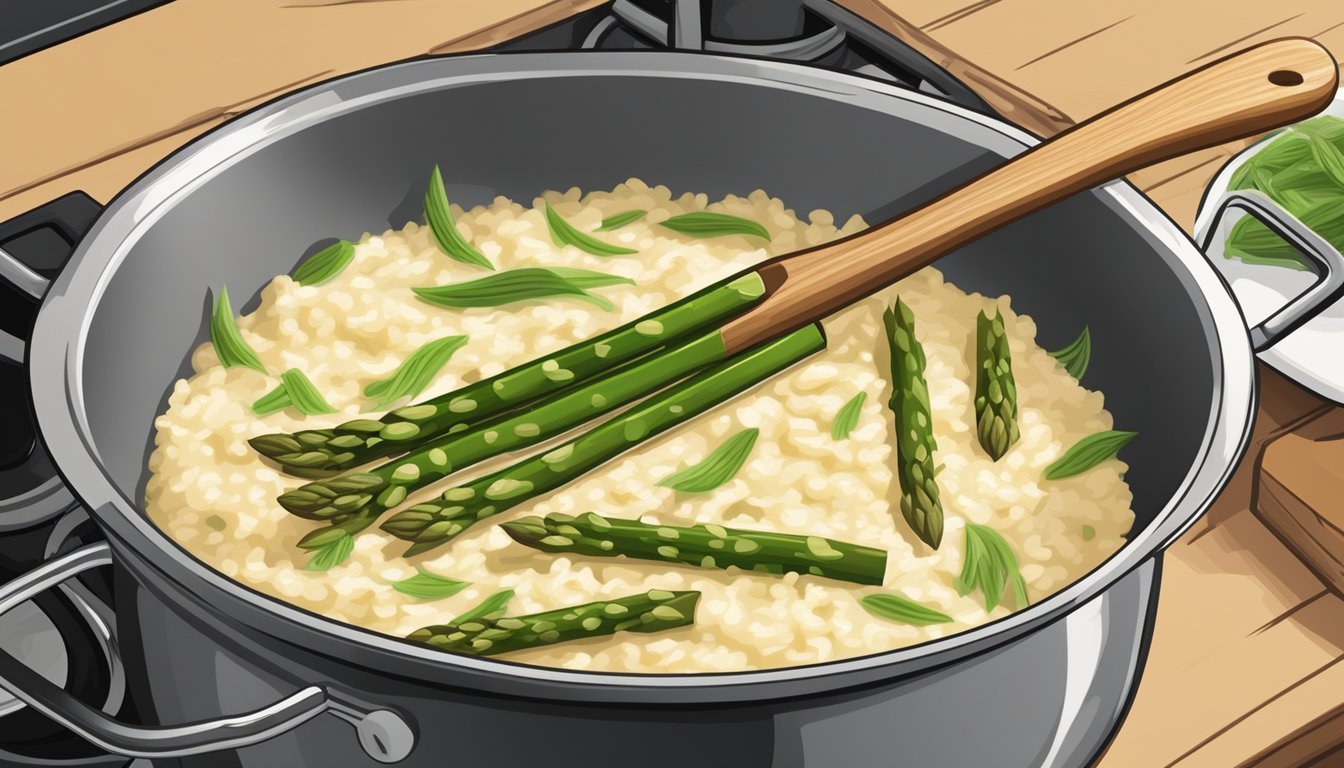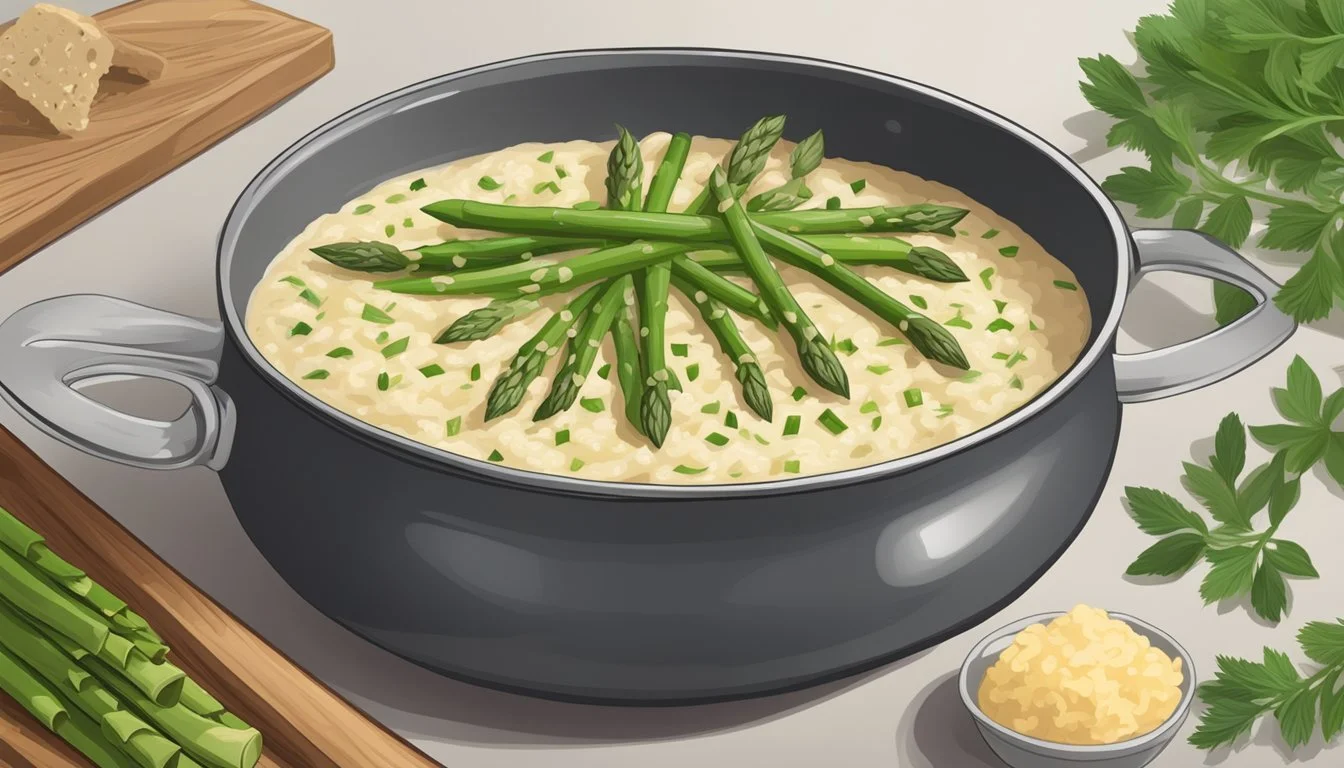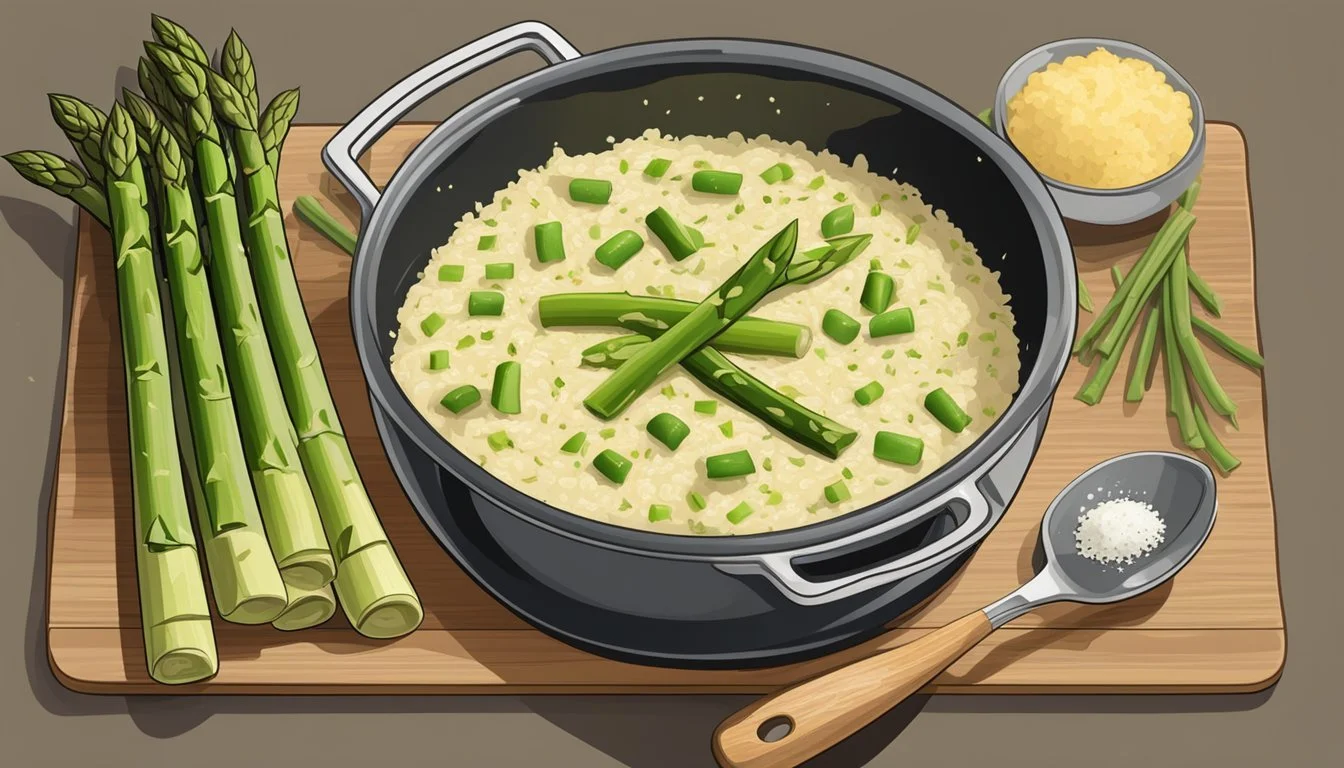Asparagus Stem Risotto
A Creamy, Seasonal Main Course Delight
As the season unfolds, the arrival of fresh asparagus heralds an opportunity to incorporate this tender green into a variety of dishes. One classic Italian dish that beautifully showcases asparagus (What wine goes well with asparagus?) is risotto, a creamy rice entree that has made its mark as a versatile main course capable of highlighting seasonal ingredients. The key to a sumptuous asparagus risotto lies in the harmonious blend of Arborio rice, a starchy short-grain rice that absorbs flavors well and contributes to the dish's signature creaminess, and the subtly earthy tones of asparagus, which can be delicately integrated into the rice or used as a crisp garnish on top.
Crafting asparagus risotto involves a patient cooking technique that gently coaxes the rice to release its starch, resulting in a velvety texture without the need for cream. The process begins by sautéing aromatics such as shallots or onion until tender, then toasting the rice to a light golden hue, which helps to awaken its nutty essence. The sequential lacing of the rice with ladles of simmering stock allows for a gradual absorption while achieving the desired al dente bite. Sliced or diced asparagus stems are typically added partway through the cooking, allowing them to become tender while retaining their vibrant color and nutrients.
As the risotto nears its creamy conclusion, final touches often include a splash of white wine for acidity, a generous sprinkle of freshly grated Parmesan cheese for a rich depth, and seasoning to taste. Seasonality plays a crucial role, not only in the freshness of the asparagus but also in the lightness of the dish as a springtime favorite. A well-prepared asparagus stem risotto, balanced in flavor and luxuriously creamy in texture, stands as a testament to the time-honored culinary tradition of risotto-making, delighting palates with the simple yet profound pleasures of seasonal eating.
Origin and History of Risotto
Risotto is a classic Italian rice dish known for its creamy texture and capacity to merge an assortment of flavors. The roots of risotto can be traced back to Northern Italy, specifically to the region of Lombardy, where the cultivation of rice became prevalent around the 14th century due to the introduction of the grain by the Arabs. It gained popularity over the centuries as an adaptable and hearty dish.
The rich soils and moist climate of the Po Valley provided an ideal environment for growing the stubby-grain rice varieties, like Arborio, Carnaroli, and Vialone Nano, which are integral to the dish's signature creaminess. These varieties are high in amylopectin, a starch that contributes to risotto's velvety consistency when cooked.
The preparation of risotto is a careful process, where broth is slowly ladled into rice sautéed with onions and coated with fat, traditionally butter or sometimes lard. The liquid is absorbed gradually, which allows the grains to release their starch and blend harmoniously with added ingredients.
Springtime heralds the inclusion of seasonal produce in risotto, such as the delicate green spears of asparagus, which infuse the dish with their grassy, slightly sweet flavors. The method of creating risotto during this period involves incorporating young, tender asparagus stalks, ensuring the fusion of spring's vibrancy into the creamy, starchy canvas.
In Italian cuisine, risotto exemplifies culinary simplicity met with technical precision. It is a manifestation of both tradition and adaptability, constantly evolving with the seasons but always staying true to its Milanese origins.
Benefits of Asparagus
Asparagus stands out for its rich nutritional profile and its optimal harvesting period during the spring season. This vegetable is an excellent addition to risotto for a health-conscious main course.
Nutritional Profile
Asparagus is a low-calorie vegetable that is high in fiber, which is essential for digestive health. It contains a variety of vitamins and minerals including vitamin K, vitamin A, vitamin C, and folate. Asparagus also provides a modest amount of protein, which is uncommon for a vegetable, making it a more nutritionally complete food. Below is a breakdown of the nutrients found in a standard serving of asparagus:
Dietary Fiber: Contributes to satiety and aids in digestion.
Protein: An essential component for muscle repair and growth.
Vitamin K: Necessary for blood clotting and bone health.
Vitamin A: Supports immune function and eye health.
Vitamin C: Plays a role in collagen formation and immune defense.
Folate: Vital for cell division and DNA synthesis.
Seasonal Availability
Asparagus is typically at its peak during the spring months. This is when it's freshest and most flavorful, making it an ideal ingredient for a seasonal dish like risotto. The young stems are tender and have the highest concentration of nutrients. By incorporating asparagus into recipes during this time, one can enjoy not only its health benefits but also contribute to sustainable eating practices by choosing seasonal produce.
Essential Ingredients
Creating an asparagus stem risotto requires a deliberate choice of high-quality ingredients. Each component plays a crucial role in bringing out the rich, creamy texture and the dish's vibrant seasonal flavors. Here is a breakdown of the essential ingredients for a successful Asparagus Stem Risotto.
Rice Selection
Arborio rice is the foundation of any risotto. This starchy, short-grain rice is preferred for its ability to absorb liquids and flavors culminating in a creamy consistency without becoming mushy.
Key Rice: Arborio rice
Vegetables and Herbs
The vegetables and herbs bring freshness and depth to the risotto. Asparagus should be fresh, with the tough ends trimmed before being cut into pieces. Shallots and garlic should be finely minced to distribute their flavors evenly. A hint of lemon zest can add a refreshing counterpoint to the richness.
Primary Vegetables: Asparagus, shallots
Herbs and Aromatics: Garlic, lemon zest (optional)
Liquids for Cooking
A combination of vegetable broth and dry white wine is used to cook the rice slowly, allowing gradual absorption and the release of starch. It's ideal to have the broth heated before adding it to the rice to maintain a consistent cooking temperature.
Broth: Vegetable broth (keep warm)
Wine: Dry white wine
Cheeses for Flavor
Cheese, specifically Parmesan, is indispensable for its salty, umami character, which intensifies the overall flavor. The addition of butter and cream offers extra richness and smoothness to the dish's finish.
Cheese: Parmesan cheese, freshly grated
Dairy: Butter, cream (optional for extra richness)
Remember that the success of your Asparagus Stem Risotto hinges on each ingredient, so choose them carefully and pay attention to their quality and the roles they play in the dish.
Step-by-Step Cooking Guide
The key to a successful Asparagus Stem Risotto lies in meticulous preparation and attention to the cooking process. By following these steps, cooks can ensure a dish with creamy texture and perfectly cooked rice.
Preparation of Ingredients
Prep Time: To begin, one should allocate around 10 minutes for preparation.
Asparagus: Trim the woody ends from the asparagus stems (about 1-2 inches), and slice the remaining stems into 2-inch pieces.
Aromatics: Finely chop shallots and mince garlic cloves.
Rice: Measure out the Arborio rice, as it does not require rinsing.
Tip: Keeping ingredients pre-measured and within reach streamlines the cooking.
The Risotto Cooking Process
Total Time: Cooking takes approximately 30 to 40 minutes, combining prep and active cook time.
Cook Time: The rice will take roughly 18 to 20 minutes to reach an al dente texture.
Step 1: In a large pot, heat olive oil over medium heat until shimmering, then add shallots, sautéing until translucent, about 1-2 minutes.
Step 2: Add minced garlic, cooking for an additional minute until fragrant, taking care not to let it brown.
Step 3: Stir in Arborio rice, toasting it lightly with the aromatics for a couple of minutes until it begins to turn golden.
Step 4: Gradually incorporate warm broth, one ladle at a time, stirring consistently as the rice absorbs the liquid and starts to release its starches.
Tip: Constant stirring and gradual addition of broth are crucial to achieving the velvety texture risotto is famous for.
Step 5: Once the rice is al dente and the mixture takes on a creamy consistency, fold in the prepared asparagus, cooking for a few minutes until it is tender yet vibrant.
Step 6: To finish, adjust seasoning with salt and pepper and, if desired, stir in butter or Parmesan cheese to enrich the risotto before serving.
Note: Maintaining a neutral heat throughout ensures even cooking and prevents the rice from becoming mushy.
Flavor Enhancements
To elevate the creamy delight of asparagus stem risotto, the infusion of well-chosen flavor enhancements is key. Thoughtful additions of seasonings and accents can turn a simple dish into a symphony of taste.
Seasonings
The foundation of any risotto's flavor profile begins with salt and pepper. These essentials should be used judiciously to underscore the natural flavors. For an aromatic touch, chefs often incorporate lemon zest and lemon juice, which bring a bright citrus note that complements the asparagus. Fine-tuning the risotto with the zest and a splash of juice just before serving ensures a vibrant burst of flavor.
Salt: A pinch to taste, balancing the dish
Black Pepper: Freshly ground for a spicy warmth
Lemon Zest: Grate just the outer layer to avoid bitterness
Lemon Juice: A squeeze to cut through the creaminess
Wine and Citrus Accents
Incorporating dry white wine early in the cooking process introduces a nuanced acidity and a depth that water alone cannot provide. The wine's crispness marries well with the tender, slightly earthy asparagus. Additionally, a finishing touch of fresh herbs, such as parsley or chives, not only adds color but an extra dimension of freshness.
Dry White Wine: Approximately half a cup, added after toasting the rice
Fresh Herbs: Lightly chopped and sprinkled before serving for a herbal note
By carefully layering these seasonings and wine and citrus accents, chefs create a risotto that's both rich and complex, ensuring each bite is a testament to the careful craft that defines outstanding Italian cuisine.
Accompaniments and Variations
Asparagus stem risotto offers a versatile canvas for numerous pairings and modifications. Whether it's added proteins and vegetables, a variety of cheese, or adapting the recipe for vegan and vegetarian diets, the risotto can be perfectly tailored to suit any preference or occasion.
Proteins and Vegetables
Mushrooms: A classic addition, mushrooms can be sautéed and stirred into the risotto, offering an earthy flavor that complements the asparagus.
Protein Type Preparation Method Shrimp Sautéd and seasoned, adding a light, seafood essence Salmon Grilled or pan-seared, flaked into the risotto Beef Thin slices of seared steak can add a robust touch
Peas: Bright green peas add sweetness and texture, enhancing the risotto's springtime appeal.
Cheese Variations
Incorporating different cheeses offers the risotto new dimensions of flavor and creaminess:
Parmesan: A traditional choice that provides a salty, nutty taste and helps to thicken the risotto.
Variations: Explore different types of cheese like Pecorino for a sharper taste or creamy Goat Cheese for a tangy twist.
Vegan and Vegetarian Options
To accommodate those following a vegan or vegetarian diet:
For a vegetarian dinner, simply omit meat-based proteins and use vegetable broth as the base for cooking risotto.
Vegans can enjoy a creamy mushroom risotto (What wine goes well with mushroom risotto?) by replacing cheese with nutritional yeast or vegan cheese alternatives and utilizing olive oil in place of butter.
Beverages like Sauvignon Blanc pair splendidly, with its crisp acidity cutting through the risotto's richness.
Plating and Presentation
A thoughtfully plated Asparagus Stem Risotto acts as the canvas upon which its flavors and textures are enhanced through garnishing and attention to serving temperature.
Garnishing for Appeal
For serves 4, each portion of the risotto should be garnished to combine elegance with simplicity. A light drizzle of lemon vinaigrette around the rim of the plate can add a vibrant zest that complements the creamy risotto. Roasted asparagus spears, with their tips pointing outward, create a visual appeal. Sprinkle finely chopped parsley and thyme to add color and aroma, while a handful of toasted pine nuts offers a contrasting texture.
Toasted Pine Nuts: Adds crunch and richness
Lemon Vinaigrette: Brightens the dish
Fresh Herbs: Enhances the dish's fragrance
Serving Temperature
Asparagus Risotto should be presented warm to ensure its rich creaminess is at its peak. The ideal temperature allows the flavors of the vegetarian dish to meld together beautifully. Each serving spoonful onto pre-warmed plates maintains the heat throughout the dining experience, underlining the risotto's status as an elegant centerpiece of a meal.
Pre-warmed Plates: Keep the risotto at the perfect temperature
Creamy Texture: Best appreciated when served warm
Pairings and Wine Selection
When serving Asparagus Stem Risotto as a main course, the selection of a complementary wine and side dishes can elevate the dining experience.
Side Dishes: Pairing risotto with a light side dish, such as a salad, can balance the creaminess of the main course. An arugula salad, with its peppery notes, or an asparagus salad, to echo the vegetable in the risotto, are excellent choices. These salads provide freshness and a crunchy contrast to the creamy risotto.
Arugula Salad - A simple dressing with lemon and olive oil.
Asparagus Salad - Tossed with a vinaigrette and perhaps shavings of Parmesan.
Wine Selection: A carefully chosen white wine can complement the dish without overpowering it. The fresh greens of the salads and the earthy undertone of asparagus call for wines with herbaceous or citrus profiles.
Wine Type Characteristics Pairing Reasoning Albariño Grassy and herbaceous with ripe citrus notes. Matches the green notes of asparagus. Grüner Veltliner Herbal and peppery, often with a touch of minerality. Complements the salads and works with creamy sauces. Aged Chardonnay Rich and often with a hint of truffle or earthiness. Pairs with the complexity of well-developed risotto. Gavi Light, with delicate floral and mineral nuances. A good all-rounder for the risotto and side salads.
Wine Temperature: It is crucial to serve these wines chilled, between 45°F to 50°F, to appreciate their full bouquet and to balance the warmth of the risotto.
Each wine brings a distinct flavor that can enhance both the risotto and the sides. Choosing the appropriate wine and side dish will result in a harmoniously crafted meal.
Storage and Reheating Tips for Leftovers
When it comes to storing leftover asparagus stem risotto, one must ensure it is cooled to room temperature before placing it in an airtight container. Refrigerate the risotto promptly, ideally within two hours of cooking. Stored properly, leftovers will remain fresh for up to 48 hours.
Upon reheating, one should focus on restoring the creaminess that is characteristic of freshly prepared risotto. Here’s a concise guide to effectively reheat your risotto leftovers:
Preparation: Measure the amount of risotto to be reheated.
Broth Selection: Opt for a low-sodium chicken or vegetable broth, which matches the original risotto recipe to preserve flavor.
Reheating Process:
For 1 cup of risotto, bring about 1/4 cup of broth to a boil.
Place the risotto in the pot, stirring gently to distribute the heat.
Amount of Risotto Broth Amount Heat Level 1 cup 1/4 cup Medium
Adjustment: If the risotto is still too thick after adding the initial liquid, incorporate more broth, little by little, until achieving the desired consistency.
Final Step: Ensure the risotto is thoroughly heated, which should take around 5 minutes, stirring occasionally to prevent sticking.
Remember, using a gentle heat will help maintain the integrity of the rice and prevent the dish from drying out. Proper reheating techniques can help preserve the texture and flavor of leftover asparagus stem risotto, ensuring a satisfying experience upon serving again.
Frequently Asked Questions
In this section, readers will find insightful information on the best cookware for making asparagus stem risotto and how to make the dish suitable for various dietary restrictions. The guidance provided is clear and straightforward, ensuring a successful culinary experience.
Choosing the Right Cookware
For optimal results, one should use a heavy-bottomed pot—ideally a Dutch oven or a deep skillet. Such cookware distributes heat evenly, preventing the rice from burning and sticking. A sturdy pot is also essential for the continuous stirring necessary for creamy risotto. Here is a quick overview of the ideal cookware:
Material: Heavy-bottomed stainless steel or enameled cast iron.
Size: At least 4-quart capacity to allow ample stirring space.
Heat Source: Suitable for your stovetop, whether it be gas, electric, or induction.
Adjustments for Dietary Restrictions
Asparagus stem risotto can be customized for vegetarian and kosher diets with a few simple tweaks. Here’s how:
Vegetarian: Use vegetable stock instead of chicken or beef broth, and consider adding a dash of kosher salt for enhanced flavor.
Kosher: Ensure all ingredients are certified kosher, including the cheese, and use kosher salt as needed.
For those avoiding dairy, swap traditional Parmesan cheese with a dairy-free alternative, and use olive oil in place of butter. Always taste and adjust the seasoning to preference, especially when altering ingredients for dietary restrictions.
Closing Thoughts
Asparagus stem risotto shines as a creamy, seasonal main course, ideal for a sophisticated dinner. The dish itself is a testament to the versatility of seasonal vegetables and offers a pleasing balance to the palate.
Serving Suggestions:
For an elegantly rounded meal, this risotto pairs splendidly with a crisp white wine, enhancing the natural flavors of the asparagus.
A garnish of freshly grated Parmesan cheese or a sprinkle of lemon zest can add a layer of complexity to this creamy entree.
Consider serving with a side of crusty bread to complement the risotto's texture.
Presentation:
Serve the risotto on warm plates to maintain its creamy consistency.
Garnish each plate with a few reserved asparagus tips for a touch of color and to hint at the main ingredient.
In crafting this dish, chefs celebrate the arrival of spring with asparagus at its heart. They approach its preparation with care to ensure the risotto is both a visual and gastronomic delight. Whether one is hosting a formal gathering or seeking to enrich their family's dinner routine, asparagus stem risotto makes for a memorable and satisfying main course.






